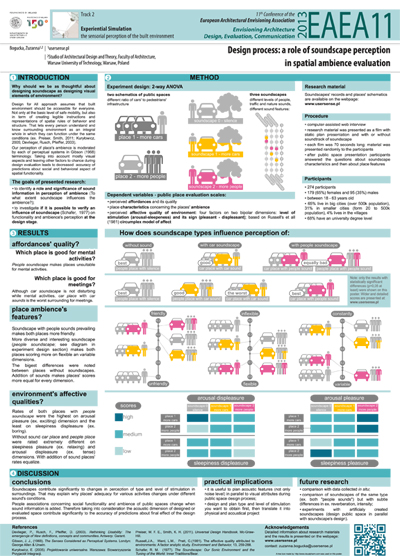11th EAEA Envisioning Architecture: Design, Evaluation, Communication Conference in 2013
Track 2 | Experiential Simulation | The sensory perception of the built environment
Design process: a role of soundscape perception in spatial ambience evaluation
Keywords: soundscape; ambience; affordances; design verification
ABSTRACT
Human and social dimensions in evaluation of built environment is, in most cases, crucial for provide a good spatial functioning in term of quality of life. From this perspective it is necessary to looking for a methods of evaluation the social functionality of built environment at the very early stage of creating it.
In evaluation of human-environment relations concerning a perception issues much attention is given to visual aspects. It seems to be natural because of its domination in human perceptions systems. Likewise the design verifications methods of social functionality are mostly based on evaluation visible aspects (ex. aesthetic evaluation (Brown and Gifford, 2001), spatial legibility based on cognitive mapping and Lynch’s terminology (1960), space syntax parameter of visibility (Hiller and Hansen, 1984)). However visual information are not the only one determinants of quality and social functionality of built environment.
Why should we be as thoughtful about designing soundscape as designing visual elements of environment?
Design for All approach assumes that built environment should be accessible for everyone. Not only at the basic level of safe mobility, but also in term of creating legible instructions and representations of spatial rules of behavior and structure. That let every people understand and know surrounding environment as an integral whole in which they can function under the same conditions (ex. Preiser, Smith, 2011; Kuryłowicz, 2005; Devlieger, Rusch, Pfeiffer, 2003).
Our perception of place's ambience is moderated by each of perceptual systems in Gibson (1968) terminology (ex. Rodaway, 1994). Taking into account mostly visual aspects and leave other factors to chance during design evaluation leads to decreasing the accuracy of predictions about social and behavioral aspect of spatial functionality.
There were two purpose of research presented in this paper: first, to identify a role and significance of sound information in perception of ambience (To what extent it influences the ambience?); second: to investigate if it is possible to verify an influence of soundspace (in Schafer (1977) terminology) quality and specificity at the design stage
In two-way analysis of variance three different soundscapes (S0 - silence
Results shows that soundscapes heard during presentation of schematic plan of public space influent places ratings in each of three scales. Soundscape's effect may change its specificity depending on type of examined location. Relation between "people" and "traffic" sounds heard in public spaces is crucial in its evaluation during design stage.
AUTHOR
Zuzanna Bogucka
Studio of Architectural Design and Theory, Faculty of Architecture, Warsaw University of Technology, Warsaw, Poland
